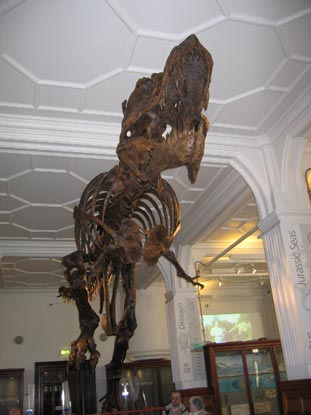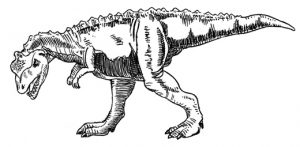New Study Suggests that Tyrannosaurs such as T. rex were Cannibals
Scientists have long suspected that apex predators such as Tyrannosaurus rex may have predated upon their own kind. After all, this behaviour is widespread in the animal kingdom today. Both crocodiles and Komodo dragons, for example, kill and eat members of their own species. For a predator, this makes biological sense as it reduces competition as well as providing a source of food.
A new study published in the on line journal PLoS ONE (Public Library of Science); suggests that top Late Cretaceous predators such as Tyrannosaurus rex may also have been cannibals.
T. rex the Cannibal?
Gashes and gouges preserved in the fossilised bones of Tyrannosaurus rex suggest that other tyrannosaurs may have fed on the carcases of their own kind, perhaps, they even hunted and killed them.
Vertebrate palaeontologist Nicholas Longrich of Yale University had discovered gashes and marks on a large theropod bone, some of which were over a centimetre deep. Noting the strata from which the fossil bone had been found; he concluded that the deep grooves in the fossilised bone was evidence of a Tyrannosaurus rex feeding. However, he was to discover later that this fossilised bone actually belonged to a T. rex. This is evidence of T. rex cannibalism, but does this also mean that these large meat-eaters actively hunted and killed their brethren?
Tyrannosaurus rex
Longrich and research colleague Dr Michael Ryan of Cleveland Museum had been studying a Canadian fossil collection for evidence of feeding behaviour in Late Cretaceous mammals, indeed evidence of “gnawed” bones were found. However, these deep gashes in the fossil bones could only be attributed to a T. rex or similar sized carnivorous dinosaur.
To read more about the research into the feeding and gnawing behaviour of early mammals: The Whole Tooth and Nothing But the Tooth.
Commenting on the large marks found in the fossil bone, Nicholas stated:
“They are the kind of marks that any big carnivore could have made, but T. rex was the only big carnivore in western North America sixty-five million years ago.”
After studying a number of tyrannosaur bones, Longrich concluded that a T. rex arm bone and three foot bones, including two toe bones (pedal phalanges) showed evidence of Tyrannosaurus rex feeding. A case of one T. rex cannibalising another T. rex.
He went onto state:
“It’s surprising how frequent it appears to have been. It could mean that they [T. rex] were really thorough at cleaning up after animals died in their environment. Or it could mean that they were killing and eating each other fairly often.”
A study of the pathology on Tyrannosaurus fossils suggests that these 13-metre-long carnivores lived short, violent lives. For example, the gracile T. rex skeleton known as “Stan” – museum specimen BHI3033, suffered a bite to the back of its head. This wound could only have been inflicted by a bigger T. rex.
Do Tyrannosaurus rex Bones show signs of Tyrannosaurus Predation?

Picture credit: Everything Dinosaur
The U-shaped and V-shaped grooves and gouges are the kind that a T. rex would have left in the bone when it was stripping meat from a carcase, the marks appear to have been made post-mortem, indicating that the animal was dead before the T. rex fed. Perhaps the cannibalistic tyrannosaur might have picked at the smaller foot and arm bones after eating most of the meat off the more accessible parts of the corpse. Alternatively, the T. rex could have used its powerful sense of smell to detect a rotting corpse, one that had already been extensively scavenged and this T. rex only had a few strips of meat on some of the smaller bones to pick at.
Photographs show two pedal phalanges (toe bones) of Tyrannosaurus, photographs A2 and B2 reveal deep gouges, perhaps indicative of Tyrannosaurus cannibalism.
However, Longrich agrees that the current evidence is not strong enough to suggest that tyrannosaurs battled to the death with the victor feeding on the body of the dead combatant.
When asked about whether tyrannosaurs fought and killed each other, Longrich stated:
“Modern carnivores do this all the time. It is a convenient way to take out the competition and get a bit of food at the same time. Cannibalism is widespread in the animal kingdom.”
Evidence of cannibalism has been found in the dinosaur fossil record. For example, at the famous Ghost Ranch site, (New Mexico), more than 100 skeletons of the basal theropod Coelophysis have been discovered. It seems that these animals perished after a prolonged drought, but not before at least one adult devoured a young Coelophysis (fossilised bones found in the stomach cavity). However, this theory has been recently challenged with the tiny bones perhaps belonging to a lizard. At least one other case of cannibalism amongst theropods also springs to mind. Teeth marks on some of the bones of the abelisaurid Majungatholus match the size, spacing and teeth serrations of Majungatholus teeth. The environment where this dinosaur lived (northern Madagascar) was prone to seasonal extremes including a prolonged dry season. Conditions where food runs short are a prerequisite for cannibalistic behaviour.
An Illustration of the Abelisaurid Majungatholus
Picture credit: Everything Dinosaur
However, according to this research there are at least four examples of Tyrannosaurus rex feeding on another T. rex, which is quite stunning when you consider how limited the fossil evidence is for cannibalistic feeding in other theropods. Perhaps it is time to re-examine the extensive fossil evidence of the allosaur A. fragilis to see if some more tell-tale teeth marks can be found.
To view models of Tyrannosaurus rex and Majungatholus: CollectA Age of Dinosaurs Prehistoric Life Models.







Leave A Comment